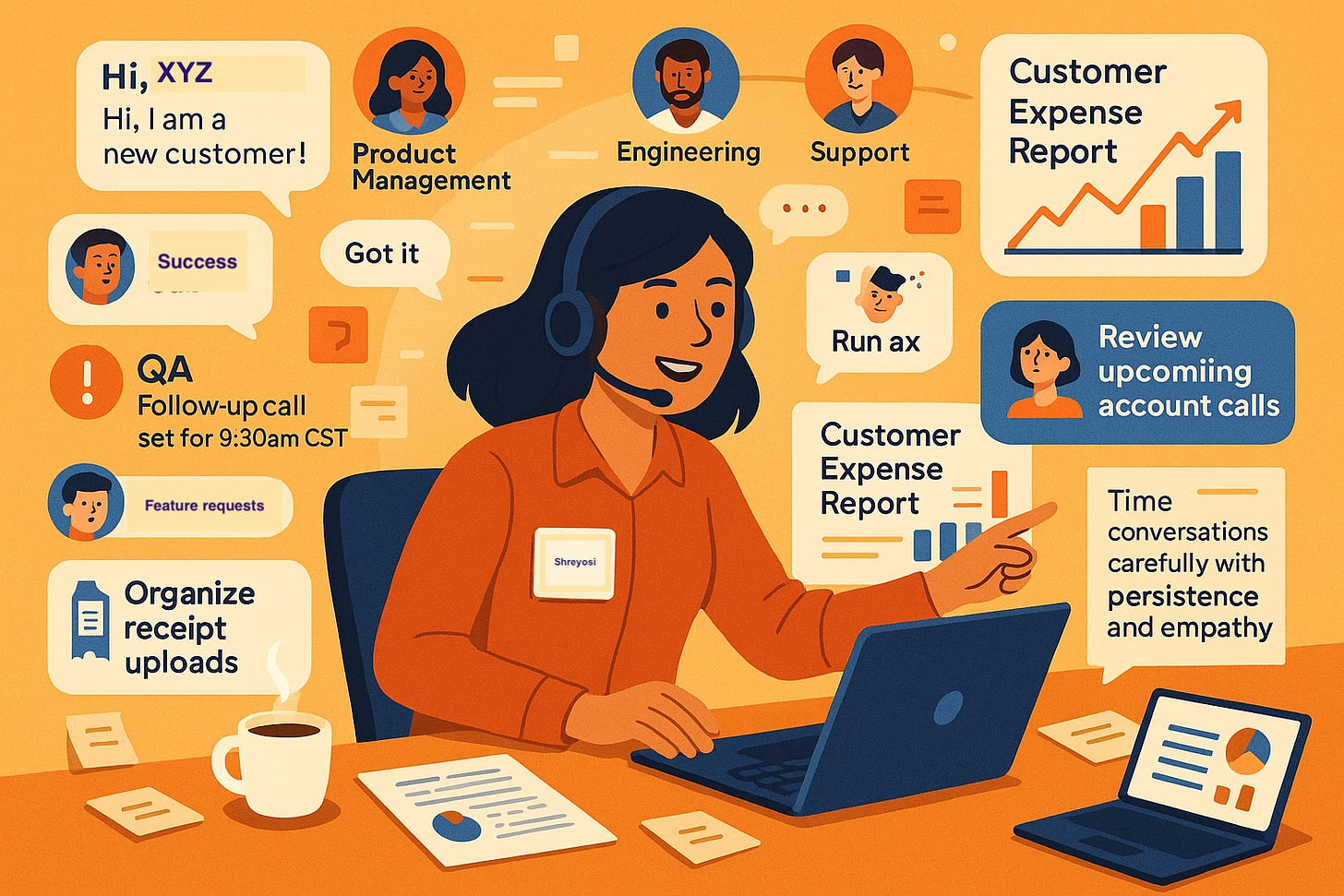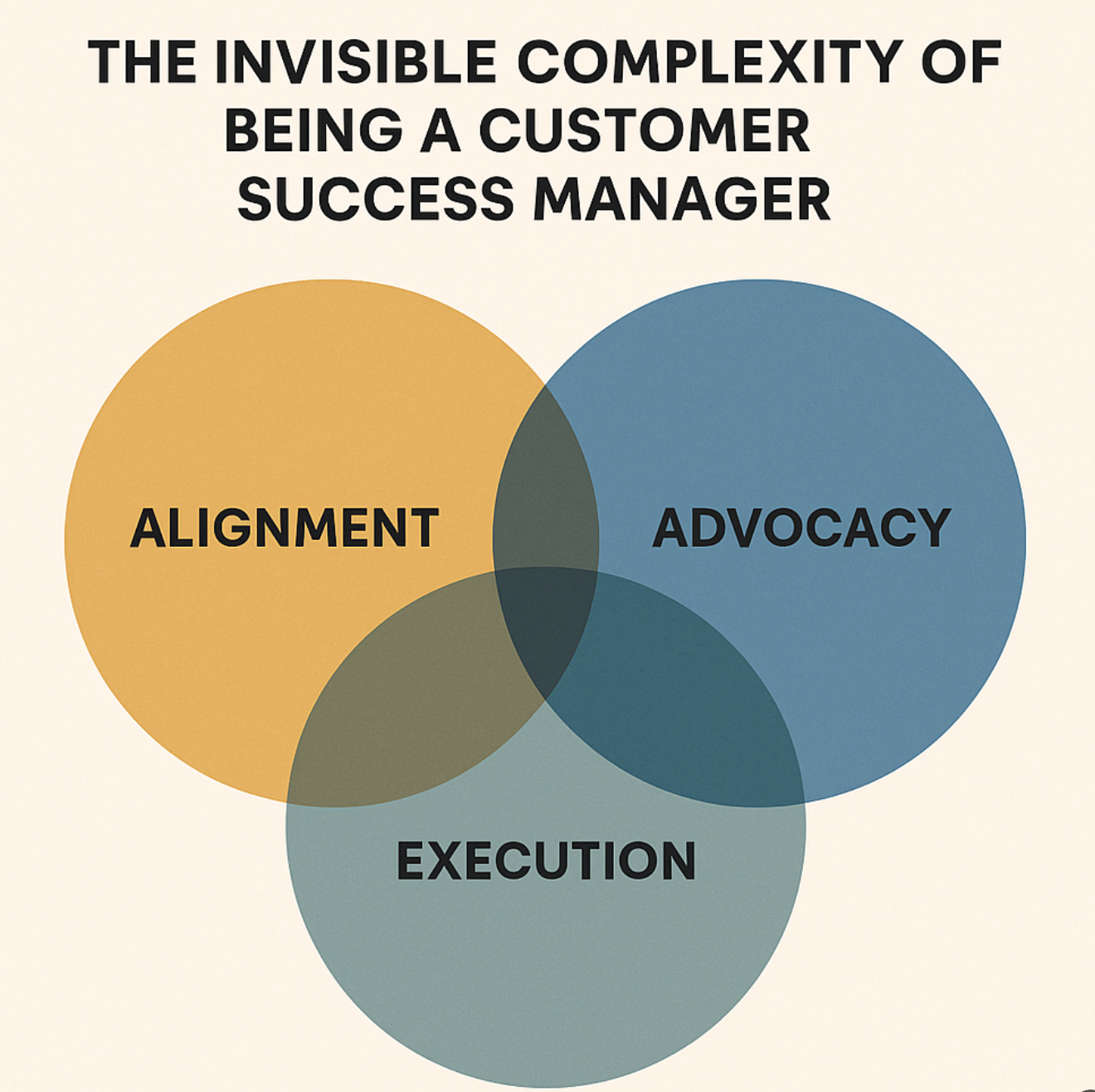Golden Rules of Engagement — Wearing the Customer Success Hat Across the Org
Bridging teams with empathy, clarity, and a customer-first mindset.
Today, I found myself reflecting on a simple yet important question: What does a Customer Success Manager really do? Beyond guiding customers towards their goals, making them feel heard, and turning their problems into achievable solutions, what more is there to it?
As I pondered and uncovered the intricacies of a CSM’s wide area of influence, I thought this could be something professionals stepping into this role can immensely benefit from.
Hi, I’m Shreyosi, and I’ve been a Customer Success Manager at Fyle. As a CSM, I enjoy driving successful outcomes for my portfolio, and my work across the organization leads me to complex and rewarding conversations with multiple teams. What truly drives impact is approaching both the customer and internal teams’ needs with empathy, strategic thinking, and clear intent.
Over time, I’ve learned how valuable it is to collaborate effectively with teams like Product Management, Engineering/Development, Customer Marketing, Operations, Support, and Billing. Whether it is advocating for roadmap visibility or pushing for urgent fixes, CSMs often walk a fine line: timing conversations thoughtfully, balancing persistence with kindness, and always keeping the customer’s voice at the center of every decision.
So in this blog, I’m excited to share what I call the Golden Rules of Engagement and what it truly feels like to wear the Customer Success hat across teams.
With that context in mind, let’s break down the key areas we’ll explore:
Navigating Invisible Complexity Across Teams
We hold an invisible complexity in being a Customer Success Manager (CSM) while working with different departments. Often, the challenge lies in balancing alignment, advocacy, and execution, all without having direct control. We become the voice of the customer, and it requires influencing different departments, which means mastering the art of persuasion and effective data-backed storytelling, as each department has its own processes and priorities.
It’s important for us to understand how to align with them and make it onto their priority list. We need to excel at ensuring that the customer’s voice is clearly heard and effectively represented. Often, this means translating feedback into structured, actionable insights that resonate with different teams, each with their own goals, language, and priorities. Since customer success is inherently cross-functional, driving impact requires strong storytelling and seamless coordination across departments. It’s essential that we work in a collaborative environment where we support one another and align on shared goals, ensuring both customer and internal success.
Behind the Curtain: CSMs at the Core of Cross-Team Alignment
Being a Customer Success Manager often feels like guiding air traffic from a quiet control tower—essential, but often unseen. We’re the steady bridge connecting customers with internal teams, often navigating without a detailed map, but still, it is required that we chart the course. While every department runs its important race, we’re the ones weaving between customers and internal teams, sometimes at a sprint to keep everything moving smoothly and everyone aligned.
Staying in Sync: The Power of Being Up to Date
One of the most important parts of being a CSM is knowing what’s happening, both with our customers and within our product. We’re the bridge between the two, and to build that bridge in the right place, we need to be armed with the most accurate and up-to-date information. Customers’ needs evolve quickly. Their goals and challenges shift often, and our product is constantly developing to keep up with those changes. At the same time, different CSMs manage different accounts, and each customer may have unique requirements. So, it becomes essential for us to stay in the loop about new feature releases and enhancements. Sometimes, those new features don’t perfectly match a customer’s needs, and that’s where our creativity kicks in. We often come up with thoughtful workarounds or best-fit solutions to keep things moving forward. But it doesn’t stop there. Part of our job is to bubble up these insights to the product team, helping them see what’s coming up repeatedly. That feedback can spark product improvements that benefit not just one customer, but many. In short, being up to date isn’t just about knowing what’s new—it’s about turning that knowledge into meaningful action for our customers and our company.
Collaborating with Stakeholders Effectively
While many teams in the organization operate on well-defined calendars and predictable workflows, the nature of a Customer Success Manager’s role often brings unexpected shifts. Flexibility becomes part of the rhythm, and we learn to navigate changing priorities with resilience and care. We’re working with customers to ensure they get value consistently, even when a glitch or a bug has thrown the plans off course. That’s why empathy is so important at all times and in every interaction.
Usually, product and engineering teams are working on long-term goals, building features and fixes that take time and planning. As CSMs, it’s our job to represent the customer voice, but in a way that’s thoughtful and constructive. When we bring up a bug, service request, or feature idea, it helps to frame it with context: What’s the impact? How many customers are affected? What’s the urgency?
Not everything can or should be treated like a crisis, and that’s okay. Keeping our tone collaborative and our messaging clear goes a long way. It builds trust when customers know their requests are prioritized effectively and internal teams are aware that requests are carefully analyzed to accord the right priority.
From Glitches to Game Plans
When something goes wrong, our role isn’t only to sound the alarm—it’s to shine a light on what’s happening and help guide everyone towards a solution. As CSMs, we’re often the first to hear about issues from customers, whether on a call or in an email. In those moments, it’s important to stay calm, focused, and constructive. Rather than reacting emotionally, we gather and share the right details to help the relevant teams downstream.
Customers may express frustration strongly, and understandably so. Our job is to listen beyond the emotion and extract the true need. That way, we can communicate urgency and context to internal teams with clarity and accuracy, ensuring the issue gets the right attention and the customers continue to use the product without fluctuations.
Be the Adapter: Translating Needs into Action
When it comes to integrations, CSMs often wear the hat of a translator. Since most SaaS products support a variety of integrations, we’re the bridge between what the customer needs and what’s technically possible. To do this effectively, we need a strong technical understanding of the systems so we can determine how the integration should work and anticipate any potential challenges. That knowledge helps us ask the right questions internally, share clear information externally, and bring in the right people when needed. It’s also our job to set expectations early, especially when integrations involve multiple steps or longer timelines. Communicating those complexities with empathy helps prevent surprises later. And when something needs a deeper dive or a faster resolution, knowing who to loop in—and when—can make a lot of difference.
Know the Dollars Before You Talk Value
A customer’s experience with billing isn’t just transactional—it’s part of their ongoing journey with us. Whether they’re on a monthly or annual plan, they deserve a smooth, transparent experience. As customer success managers, we stay informed not to intrude but to be helpful. Understanding a customer’s billing history, subscription preferences, and any unique terms ensures we’re prepared to assist thoughtfully and accurately when questions arise.
This level of support is made possible through close collaboration with our billing and finance teams. Staying in sync on billing status, subscription structures, and plan details allows us to guide customers confidently and efficiently when they need clarity or direction.
We also keep an eye on product usage—not to micromanage, but to proactively add value. If we notice trends like unused seats or potential overages, we reach out with recommendations that help customers get the most from their plan. These conversations, when handled with care and backed by internal alignment, build trust and reinforce that we’re invested in their success and not just the sale.
Wrapping It Up: No Map, Just Mission
Most people don’t realize how many hats a Customer Success Manager wears—until things get real. We’re the ones navigating customer expectations, urgency, and emotion, often without a warning. When we appear suddenly in a thread or a meeting, it’s not chaos; it’s because something critical is on the line, and trust is being built (or rebuilt) in that moment.
Our priorities shift dynamically, but we’re still expected to get everyone to the destination on time and in one piece. We are the voice of the customer and the ear of the company: translating needs, managing expectations, and making sure the right message reaches the right team at the right time. Because at the end of the day, internal alignment isn’t just nice-to-have; it is a must-have.
Stakeholder success = Customer success.
Thank you so much for taking the time to read my blog!
—THE END—









